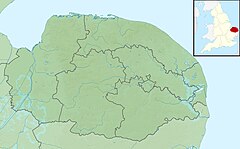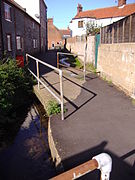- The Blue Plaque on the wall of a Cottage in Beeston Road, Sheringham, marks the location of Sheringham watermill (Paper).
- Beeston Beck's course at the Back of the Houses on Beeston Road.
- The Beck flowing through woodland on Beeston common.
- The Back common in Sheringham
- Until 1901 the Beck marked the border between the parishes of Beeston Regis and Sheringham.
- The Beck's outfall on to the east beach at Sheringham.
| Beeston Beck | |
|---|---|
 Beeston Beck at Sheringham Back Common | |
| Location | |
| Country | England |
| State | Norfolk |
| Region | East of England |
| District | North Norfolk |
| Physical characteristics | |
| Source | Sheringham Woods |
| Mouth | East Beach, Sheringham |
• coordinates | 52°56′43″N1°12′49″E / 52.94528°N 1.21361°E |
| Length | 1.437 mi (2.313 km) |
| watermills Sheringham Watermill(Paper & Corn) Total Fall meters from source to merger | |

Beeston Beck is a minor watercourse in the north of the county of Norfolk, England. [1]








